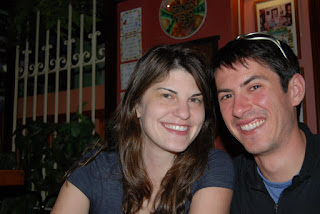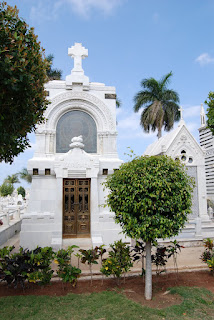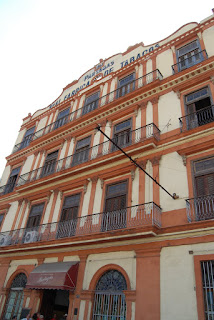
La Habana is a beautiful city. Yes, we were prepared to see the unkept architectural magnificence, and the signs of a deficient infrastructure; but it is still a majestic city. Upon our arrival on Monday afternoon, we followed the advice of Pepe, the husband of the owner of the "casa particular" we stayed in. We headed for La Torre, a bar and restaurant (we followed his advice not to eat there) to have a drink and watch the sunset. Well, we got a lot more than we bargained for-a 360 degree view of the city from La Torre's 33rd floor vantage point

West-southwest view
Best view from La Torre was east. The Hotel Nacional dominates the left foreground of this image.
Southeast view of the city
Want to guess how old these gas pumps are? The station is non-functional and so were the pumps
Vegetable and fruit market-Cubans can buy as much as they want with the national peso-the currency Cubans used (as compared to the CUC, the higher value Cuban currency used by tourist and by Cubans who can get access to it. 1 CUC = 25 pesos). Pork is the national meat; it is plentiful and accesible with pesos
The Chinese cemetery on the left. On Wednesday, our third day in Havana, we did our own walking tour (about 5 miles) starting in Vedado and heading east to Centro Habana and Habana Vieja (Old Havana). Just a few blocks into our walk, still in Vedado, we stumbled upon Jalisco Park, the amsument park where my parents used to take me as a child-it's still open and functional
On the left is an interestingly shaped apartment building. On the right is the majestic entrance to the "Necropolis de Cristobal Colon" (cemetery), currently under repair.
The majesty of one of the oldest and largest cemetery's in the America's caught our eye as can be seen in the next several frames
24 hour cafeteria. The options for nourishment in such places is minimal, but one can typically satiate the hunger pains without difficulty
Plaza de la Revolucion-Cuban flag on the left Jose Marti's statute center
School of Orthodontistry-Centro Habana
The aroma of freshly baked bread poured out of this building, one of many bread baking locations in the city. These bread bakeries take pesos and are easily accesible to Cubans, as long as you get there earlier rather than later when the bread may run out
Iglesia del Sagrado Corazon de Jesus, Habana Vieja
Hardware store (ferreteria) in Habana Vieja
Most Cuban exiles remember Almacenes Ultra as a top notch department store in Habana Vieja

Big "Roble" tree in the "Parque de la Fraternidad" next to the Capitol
Acorss the street from "El Capitolio" (Capitol) we stopped for lunch at "los Nardos", one of about 3 Spanish social clubs that have survived the test of time and the revolution. Upstairs is a perfectly air-conditioned full restaurant serving typical Spanish food
El Capitolio (notice our gang, except for yours truly) in the foreground)
Partagas, probably the best known Cuban cigar maker, is housed in this building behind El Capitolio
The "Centro Gallego" (Galician Center), now the Gran Teatro de la Habana, is an architectural masterpiece
Bacardi building, once the hub of the Bacardi rum dynasty
Iglesia del Santo Angel, my uncle Tio Coco, sent me here on an errand to try to locate a very old certificate (1800's) of marriage from our family. Unfortunately, the church was locked and nobody was available in the afternoon when we went there
Palacio Presidencial (Presidential Palace), of course not utilized as living quarters by Fidel or Raul.
The Granma, the boat in which Fidel traveled from Mexico to Cuba when he started the revolution is enshrined in this building (with 24/7 heavily armed guards) behind the Presidential Palace. It has been an everlasting symbol of the revolution
El Morro castle, behind us, marks the entrance to "La Bahia de La Habana" (Havana habor)
La Cabana, massive fortress behind El Morro, was utilized by many Cuban rulers as a prison. Some of the horrific stories of imprisonment and prisoner deaths, including those by Castro's well known firing squads, took place here
Fishing boats moored at the entrance to the harbor
Calle de adoquines (cobblestones) in Habana Vieja
Catedral de San Cristobal de La Habana (Havana's Cathedral)
Statute of Carlos Manuel de Cespedes, Cuba's first patriot in the quest to gain independence from Spain
"Museo de la Ciudad" (City Museum), formerly the Municipal Government building.
Amazing architecture in Habana Vieja
An old neon sign marks "La Pina de Plata" (The Silver Pinapple"), a restaurant
At the end of our long walking tour, stopping at "El Floridita" was a must. Here is where Ernest Hemigway hung out and enjoyed sipping on daiquiris.



























































































